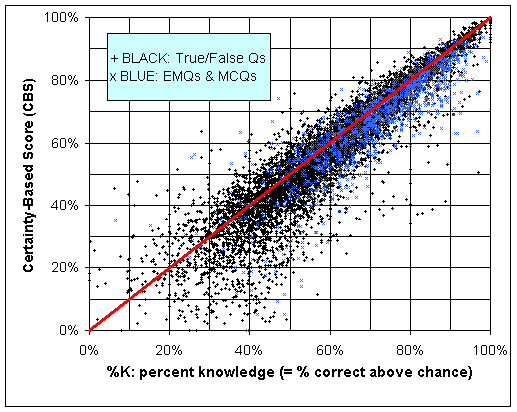% Correct or 'Accuracy' :
This is simply the percentage of those
questions that you responded to, that you got right.
Passmarks based on % Correct depend very much on the type of questions in the exercise.
For True/False questions a passmark will be well above 50%, because you could expect 50% Correct by just guessing.
Knowledge Score (% above chance, %K) :
Here the % Correct is adjusted for the proportion of correct answers that you could have expected just by guessing
.
%K is scaled [see footnote] so complete guesses would on average give %K=0%. All correct would give %K=100%.
This is a better indication of performance, though it takes no account of whether you have insight into what you know.
A typical passmark (depending on the the standard expected and difficulty of the Qs) is often around %K=50%
- half way between ignorance (pure guesswork) and complete knowledge.
Serious misconceptions can lead to a negative % Knowledge score (worse than guessing!). This is usually treated as zero.
For True/False questions %K=50% corresponds to % Correct=75%. For open answers (e.g. calculations) they may be equal.
Neither Accuracy nor your simple Knowledge score takes account of your certainty ratings.
Certainty-Based Bonus :
A positive bonus rewards effective discrimination between sound answers and those where your knowledge is uncertain.
Certainty-Based Score (CBS) :
This is based on your Certainty Based Marks
.
Like %K, CBS is scaled [see footnote] so guessing (with C=1) on average gives 0%, while all correct (at C=3) gives 100%.
The scaling ensures that at all levels of ability, average CBS is close to %K (see GRAPH), based on past experience.
Whatever your level, if you can successfully distinguish uncertain and reliable answers, your CBS should be better than your %K.
- if your CBS is lower, then try to justify each answer and look for reasons to think it reliable or to have reservations.
Your answers are of little value (and indeed are not really knowledge) if you don't know when they are reliable.
If either your CBS or %K is low, you are probably best to study the subject more before looking at more questions.
 GRAPH: The plot shows 10,000 online LAPT scores (each based on at least 20 Qs).
Black points are for True/False Qs and blue points for Multiple Choice (1 out of 5) and EMQs (Extended Matching Qs).
You should aim for high CBS scores, above the red line (CBS=%K), indicating that you are distinguishing well between reliable and unreliable answers.
GRAPH: The plot shows 10,000 online LAPT scores (each based on at least 20 Qs).
Black points are for True/False Qs and blue points for Multiple Choice (1 out of 5) and EMQs (Extended Matching Qs).
You should aim for high CBS scores, above the red line (CBS=%K), indicating that you are distinguishing well between reliable and unreliable answers.
Tips :
This way you will get the best CBS, you will train yourself to be a reliable judge of
what you know, and you will force yourself to think more deeply about
the issues underlying a question, tying together different related things that you may know.